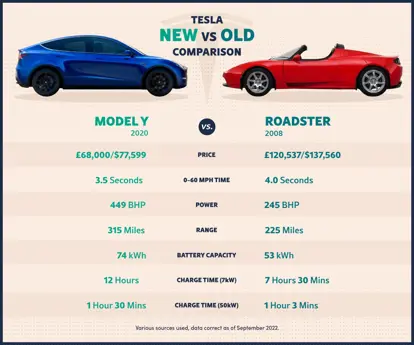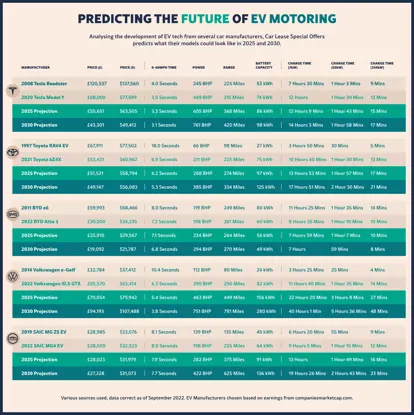The race to mainstream EV motoring
The electric car market has come a long way since the Nissan Leaf launched more than a decade ago as the first real mass-production electric vehicle (EV). Many more have arrived in the years following, each pushing the envelope a little more and closing the gap to petrol and diesel alternatives.

To analyse exactly how much that gap's narrowed, or even closed completely on certain factors, we compare the earliest and most recent EVs from the world’s top car brands. Our interactive comparison tool looks at the gains made in acceleration, range and other areas to show which manufacturers have embraced electric motoring the most.
By analysing the rate of development, we’re also able to estimate the potential stats of future models as we move towards the 2030 ban on the sale of new petrol and diesel cars.
Ford has progressed more than any other carmaker since it's first EV
When reviewing the data on an overall scale, we ranked each of the 13 manufacturers across 5 metrics and how they’ve developed between the first and latest EV: speed, range, price, power and battery capacity.
Ranking the manufacturers on their development across 5 factors
| Make | Price | Speed | Power | Range | Battery Capacity | Average Rank |
|---|---|---|---|---|---|---|
| 1. Ford | 8 | 2 | 1 | 2 | 2 | 3 |
| 2. Toyota | 4 | 1 | 2 | 5 | 5 | 3.4 |
| 3. Nissan | 12 | 3 | 4 | 3 | 3 | 5 |
| 4. BMW | 13 | 8 | 3 | 1 | 1 | 5.2 |
| 5. Honda | 1 | 4 | 6 | 8 | 9 | 5.6 |
| 6. Volkswagen | 10 | 7 | 5 | 4 | 4 | 6 |
| 7. Tesla | 3 | 9 | 8 | 7 | 8 | 7 |
| 8. MG (SAIC) | 5 | 13 | 11 | 6 | 6 | 8.2 |
| 9. Porsche | 9 | 5 | 7 | 13 | 10 | 8.8 |
| 10. Audi | 7 | 6 | 10 | 10 | 12 | 9 |
| 11. BYD | 2 | 11 | 9 | 11 | 13 | 9.2 |
| 12. Mercedes-Benz | 11 | 10 | 12 | 9 | 7 | 9.8 |
| 13. Volvo | 6 | 12 | 13 | 12 | 11 | 10.8 |
Each manufacturer's ranked out of 13 on their development across 5 EV factors, with an average rank indicating how much they progressed across the board. The lower the average rank, the better the manufacturer scored.
The results show that Ford's progressed the most, ranking in the top 2 for 4 of the 5 factors (speed, power, range and battery capacity). The Ford Mustang Mach-E GT's made such a vast improvement in every area on the 2011 Ford Focus Electric, showing immense progress for the famous American name.
Toyota and Nissan also ranked in the top 3, with the former ranking first for its progress on the speed front while being top 5 for the rest.
Tesla was surprisingly middling on this ranking, appearing down in seventh. They may argue that this was due to the 2008 Roadster being a fantastic first EV and thus leaving little room for progress. Volvo, meanwhile, struggled to keep up and finished bottom of the pile.
Ford, BMW and Volkswagen advance well year on year
When year-on-year progression was taken into account to even the playing field, Ford still reigned supreme, scoring well across the board. BMW and Volkswagen were the big winners here, though, making jumps into positions 2 and 3 respectively, with these manufacturers progressing at a faster rate each year than their competitors.
Ranking the manufacturers on EV progression per year
| Make | Price | Speed | Power | Range | Battery Capacity | Average Rank |
|---|---|---|---|---|---|---|
| 1. Ford | 7 | 3 | 3 | 2 | 3 | 3.6 |
| 2. BMW | 12 | 6 | 2 | 1 | 1 | 4.4 |
| 3. Volkswagen | 9 | 4 | 4 | 3 | 2 | 4.4 |
| 4. Nissan | 8 | 5 | 6 | 5 | 4 | 5.6 |
| 5. Porsche | 11 | 1 | 1 | 13 | 8 | 6.8 |
| 6. MG (SAIC) | 5 | 13 | 7 | 4 | 5 | 6.8 |
| 7. Toyota | 4 | 8 | 9 | 7 | 7 | 7 |
| 8. Audi | 10 | 2 | 5 | 8 | 12 | 7.4 |
| 9. Mercedes-Benz | 13 | 7 | 8 | 6 | 6 | 8 |
| 10. Tesla | 2 | 11 | 10 | 9 | 9 | 8.2 |
| 11. Honda | 3 | 9 | 12 | 10 | 10 | 8.8 |
| 12. BYD | 1 | 12 | 11 | 12 | 13 | 9.8 |
| 13. Volvo | 6 | 10 | 13 | 11 | 11 | 10.2 |
Each manufacturer's ranked out of 13 on their development per year across 5 EV factors, with an average rank indicating how much they progressed across the board. The lower the average rank, the better the manufacturer scored.
Chinese giant BYD's making huge strides on the worldwide sales front, but their year-on-year EV development leaves a lot to be desired, ranking twelfth out of 13 on our list. Tesla's also down in eleventh, with CEO Elon Musk perhaps having other things on his mind.
Teslas last 40% longer between charges than they could 14 years ago
Since its first model, the Roadster, was unveiled in 2008, Tesla has made leaps and bounds in the development of EV tech. The Model Y manages 90 miles more than the Roadster on each charge, a 40% increase.
Such is the improvement across the automotive industry, however, the carmaker hasn’t managed the biggest jump in range – far from it, actually. While BMW’s first EV, the i3, travels only 70 miles between charges, the more recent iX will do 315 miles, a huge 350% increase.
Just behind is Ford with a 308% increase between the Focus Electric, which didn’t reach the UK, and the Mustang Mach-E GT (76-310 miles). As the builder behind the world’s first mainstream motor, the Ford Model T, it shows a willingness from even the most traditional car manufacturers to move with the times.
Also scoring well is Volkswagen, increasing range by 213% between 2014’s e-Golf and this year’s ID.5 GTX (80-250 miles).

Data predicts Porsche’s EVs will be more than twice as powerful as an F1 car by 2030
By looking at the rate of development between each manufacturer’s earliest and most recent EVs, we’re able to predict what further improvements can be made by 2025 and 2030.
.jpg)
In only 3 years, Porsche increased the power of the Taycan by 89% (396bhp in 2019 to 750bhp in 2022). If it continues at that rate, its models will reach 1,420bhp by 2025 and 2,538bhp by 2030 – 2.5 times that of a Formula 1 car.
However, efficiency's expected to reduce by 2030 as Porsche’s latest EV, the Taycan Turbo S, manages 7 miles less per charge than the company’s first EV, the original Taycan. That said, the Turbo S is a much more performance-focused machine, prioritising power and performance over all else. It manages 0-60mph in only 2.8 seconds.
BMW’s EV exploits again stand out, with the brand’s models expected to come with a 1,555-mile range by 2030, based on the 350% increase in efficiency between the i3 and iX. For context, that’s very nearly enough to go from Land’s End to John O’Groats and back on a single charge.
Ford’s range projection for 2030 was also extremely high at 1,004 miles, with Volkswagen in third on 781 miles. With the 2030 deadline on new petrol and diesel sales looming, these promising figures will likely turn the heads of even the most traditional motorists.

Emerging EV brands from China offer affordable electric cars
It’s not just the big-name brands like BMW and Tesla that are impressing in the electric car market. Chinese manufacturers are also emerging and providing more affordable avenues into EV motoring.
In terms of worldwide sales, Shenzhen-based BYD has made huge strides in the last few years, selling 593,000 electric vehicles in 2021 compared to Tesla’s 936,000. Since 2019, BYD sales have increased by 158%.
Although range only improved by 12 miles between the BYD e6 in 2011 and the Atto 3 in 2022, those sales figures suggest buyers aren’t too concerned. While many manufacturers are pushing the limits of what an EV can do, the door is open to smaller, inexpensive carmakers – the sort that could drive volume sales and fast-track the UK’s switch to electric.
Another doing that is MG, a British firm owned and relaunched by China’s SAIC Motor. Our research shows that MG improved power and range by 42% and 67% respectively in only 3 years, between 2019’s ZS EV (139bhp, 135 miles) and 2022’s promising MG4 EV (198bhp, 225 miles). By 2030, MG’s electric cars could be capable of 422bhp and 625 miles.
Current chargers are capable of charging a 1,000-Mile EV within 50 minutes
Not only are future EVs capable of impressive range, but they’re also expected to slash charge times. While charging that undercuts the time taken to fill up at a petrol or diesel pump is perhaps some way off, the times could be greatly reduced in the coming years.
Based on the most powerful charging points right now, around 350kW, all but one of the models in our future projections are capable of charging 0-100% in less than an hour. By our calculations, Ford EVs in 2030 could be capable of 1,004 miles per charge from a 269kWh battery, which would be topped up in only 46 minutes at a 350kW charge point. However, chargers could become much more powerful over the next 10 years, with the potential to drop charge times even more dramatically.
Will Bullen, an automotive expert at Xcite Car leasing, added: “Sales in EVs worldwide have continued to grow with the ban of petrol and diesel approaching, as well as fuel prices and cost of living, in general, causing people to turn to the EV market.
“With more enquiries coming in for leasing EVs, the improvement from each manufacturer’s earliest models to now is reflected in the increased interest, and customers are seeing the benefits. Our research shows the latest EVs are 112% more powerful on average, with 92 miles of range more than their predecessors. Considering that, paired with the real potential of saving money, it's no wonder more people are buying into them.”
If you’re considering making the switch to EV motoring, check our electric car lease deals covering the latest makes and models.
Methodology
We researched 13 of the richest car brands in the world, listed according to their recent earnings by CompaniesMarketCap.com.
We reviewed their first fully electric cars and directly compared them to the latest iterations, on price, acceleration, power, range, battery capacity and charge time. All of this research is contained within our interactive comparison tool.
For the 2025 and 2030 projections for each manufacturer, we worked out the progress each brand had made from their first to their latest EV release and applied this rate of development to the next 3 years for the 2025 figures and the next 8 years for the 2030 figures.


